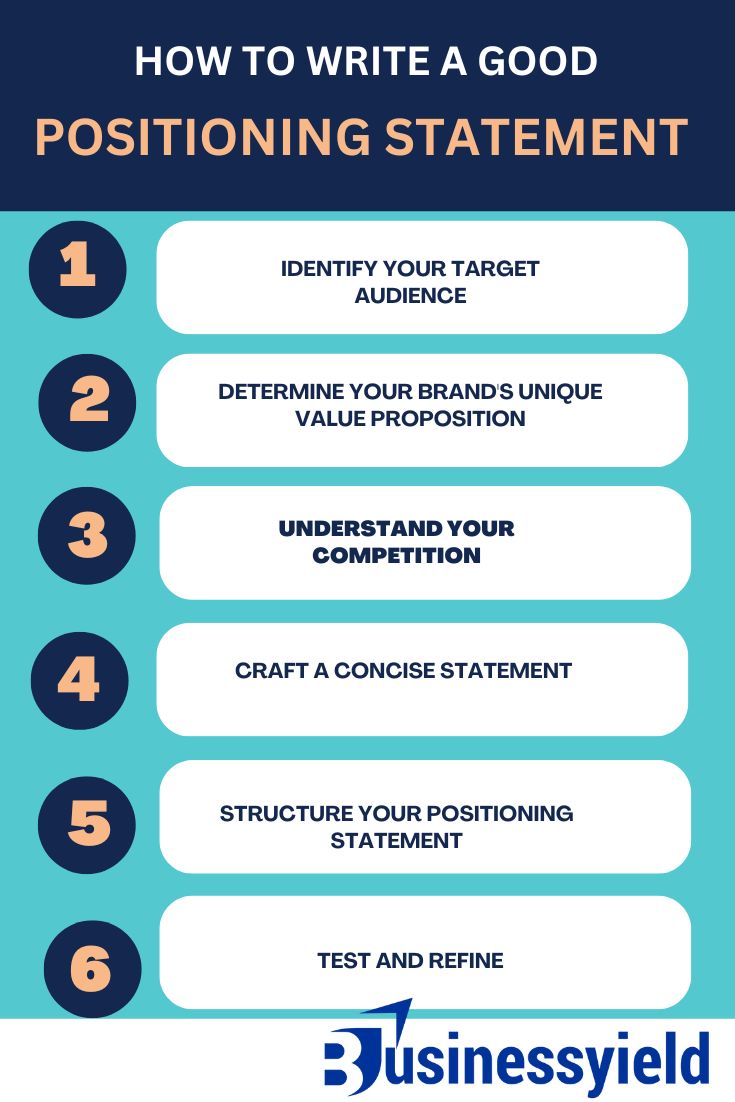Over the years, I’ve studied business operations to uncover the secret behind brands’ success and unique differentiation. I’ve concluded that there are vital elements that make every business stand out. This includes its vision and mission statement, value proposition, positioning statement, and the entire branding strategy encapsulated in its marketing and advertising activities.
Today, our focus is on positioning statements and how they drive customer loyalty. Crafting a compelling positioning statement isn’t just a task—it’s a journey I’ve been on countless times throughout my career in marketing. From working with tech startups to established retail brands, I’ve learned that pouring your heart and soul into every aspect of it is key. Each positioning statement I’ve crafted has felt like sculpting a masterpiece—a unique expression of the brand’s essence and values. The aim is simply to ensure your business positioning statement resonates deeply with customers and prospects on a personal level. There’s so much you’ll learn from this guide, trust me!
KeyPoints
- A positioning statement is a succinct declaration that expresses how a brand wants its target audience to perceive it in comparison to its rivals.
- It helps the brand figure out who they are, who they’re serving, and what makes them special.
- The four cornerstones of a brand positioning statement are its target audience (consumers), the market segment, the distinctive selling points, and the expected benefits
- A brand’s positioning statement differs from its mission and vision statement
- Apple, McDonald’s, Coca-cola are some of the brands with captivating positioning statement
What is a Positioning Statement?
A positioning statement is a succinct declaration that expresses how a brand wants its target audience to perceive it in comparison to its rivals. It’s a short and sweet way of saying, “Here’s who we are, who we’re for, and what makes us different.”
It’s like giving your brand a personality and a purpose. I’ve realized it helps people understand why they should choose you over your competitors. Let me share with you a personal anecdote that illustrates the importance of a positioning statement. Early in my career, I worked with a startup that was struggling to differentiate itself in a crowded market. Through extensive market research and field experience, we crafted a positioning statement that succinctly communicated the brand’s unique value proposition. It served as a north star for our marketing efforts, guiding our messaging and resonating deeply with our target audience. It was a cake brand, and we came up with something unique.
Everything Cakes is made with love and care to ensure that every bite reveals our sincere desire to satisfy your taste buds and cravings.
Why Does it Matter?
From my years of experience, I can attest to the importance of a positioning statement in helping a brand stand out in a competitive landscape. I can tell it’s not just about conveying who we are and what we do. It’s about building a connection with your audience on a personal level. Through my work with various brands, I’ve seen firsthand how a well-crafted positioning statement can transform a business, driving customer loyalty and long-term success.
What are the 4 Points of a Positioning Statement?
The four cornerstones of a brand positioning statement are the following: the intended consumers, the market segment, the distinctive selling points, and the expected benefits. These components are fundamental to a brand’s strategy and identity; they make the brand memorable and help it stand out from the crowd.
Why Certain Positioning Statements Work Better than Others
Over the years of studying and analyzing successful brands positioning statement, I’ve come to two conclusions. First, people prefer to do business with brands that genuinely value them rather than those who are just interested in making a quick buck off of them. Secondly, they want to know what makes you different from other brands. A positioning statement that successfully communicates the product’s value to consumers and sets it apart from competitors will always be successful. That is why it’s important to know your audience inside and out to design a winning approach.
The best way for any business to win over an audience and keep them coming back for more is to zero in on what makes them tick emotionally and psychologically, and then craft messages around those themes.
When writing your positioning statement, you must be true to yourself, no matter what. That is, be authentic, genuine, and real. This is because people can spot a fake over time, so don’t try to be something you’re not. Simply embrace who you are, flaws and all, and watch as the world embraces you in return.
Is Positioning Statement Same as Mission Statement
Not in the slightest. When it comes to defining a brand’s identity and market strategy, mission statements and brand positioning statements are distinct, but they play key roles, each with its distinct purpose.
Read Also: How to create a Compelling Mission Statement for any Business
Why Do You Need a Positioning Statement for Your Brand?
Let me share a personal analogy that illustrates the significance of a positioning statement. Just like a campfire on a cold night, a positioning statement provides warmth and comfort, drawing customers in and inviting them to experience something special. It’s about more than just selling a product or service—it’s about building a connection and becoming a part of their lives. Through my experiences, I’ve seen how a strong positioning statement can turn customers into brand advocates, fostering loyalty and trust.
From the top brands in the world, it’s obvious that a good positioning statement makes you different, and unique and remains sustainable long after you’re gone. It’s about building a legacy, a story, and a legend.
Read Also: Most Valuable Brands of the World
How Do You Write a Good Position?

Drawing from my extensive experience in crafting positioning statements, I’ve developed a set of guidelines that have proven effective time and time again. It starts with identifying your target audience and understanding their needs and preferences. From there, it’s about highlighting what sets your brand apart and crafting a concise statement that resonates with both your audience and your values. Through testing and refinement, you can ensure that your positioning statement effectively communicates your brand’s value proposition. With this knowledge at the back of your mind, the guidelines below will help you craft a compelling positioning statement.
#1. Identify your Target Audience
Start by understanding who you’re trying to reach. To do this, you must clearly define the specific group of people or businesses you want to target with your product or service. Think about their needs, preferences, and what matters most to them. Demographics, psychographics, and other relevant characteristics will help you pinpoint your target audience.
#2. Determine your Brand’s Unique Value Proposition
By this, I mean you should highlight what makes your brand special or what sets your product or service apart from competitors. You’ll have to figure out what sets you apart from the competition. Generally, it could be a unique feature, a different approach, or just a genuine passion for what you do.
#3. Understand your Competition
Take a look at what others in your line of business are doing. This will help you understand their strengths, weaknesses, and market positioning. You can use the SWOT analysis as a guide to identify opportunities to differentiate your offering. In other words, knowing what’s out there can help you find your own space to shine.
#4. Craft a Concise Statement
I have a short acronym for this, “KISS.” Keep it Short and Simple. Ensure your positioning statement is clear, concise, and easy to understand, and remember. Try as much as possible not to overload it with jargon or unnecessary details.
#5. Structure your Statement
Think about the basic structure of your statement, but don’t be afraid to play around with it until it feels right. It should resonate with both your audience and your values.
Generally, a good positioning statement often follows this structure:
For [target audience], [product/service] is the [category/industry] that [differentiates/benefits] because [reason why it matters].
#6. Test and Refine
To test and refine, you can share your positioning statement with colleagues, stakeholders, or potential customers to gather feedback. Refine your statement based on their input to ensure it effectively communicates your value proposition.
Business Yield Positioning Statement Checklist
Download Business Yield Positioning Statement Checklist
Brand Positioning Statement Example
Allow me to share some real-world examples of positioning statements from top brands and how they resonate with their target audience. By analyzing these examples, we can gain valuable insights into what makes a positioning statement successful and how it can drive customer loyalty.
#1. Apple: Think Different
“Apple creates beautifully designed products that seamlessly integrate technology into people’s lives, offering simplicity, elegance, and a superior user experience.“
How It Relates to Its Target Audience and Value Proposition
Apple’s positioning statement is crafted with precision, creating a clear depiction of its brand essence. It confidently presents the brand as the top leader in computer and mobile device manufacturing. Everyone knows they lead in innovation and advanced technology, all while prioritizing social and environmental responsibility. This statement exudes confidence and charisma, establishing their position as a leader in the consumer technology industry.
#2. Nike: Just Do It
“For athletes of all levels, Nike is the sports brand that provides innovative and performance-driven athletic gear and apparel.”
How It Relates to Its Target Audience and Value Proposition
Nike’s message is straightforward yet powerful. It’s more like a call to action, reminding its target audience that success is within reach for anyone willing to lace up their shoes and give it their all. The truth is that everyone needs this kind of motivation.
Nike wasn’t always at the top of the world of athletic footwear. Contrary to what you may have believed, Nike started as the underdog in the industry but turned things around with their famous “Just Do It” tagline. First, they tell you who you are—a hero—and then convince you to take a bold step. That shift propelled Nike to the forefront, inspiring a global community of passionate athletes.
Their message isn’t just a slogan; it’s an anthem, urging athletes to push their limits with innovation and performance. Nike’s not just about making gear; it’s about helping individuals, regardless of who they are, unlock their full potential.
Nike’s message resonates with people’s aspirations everywhere. It’s not just about selling products; it’s about building a supportive community that understands athletes’ needs and desires. And at its core, it’s about sticking to principles that inspire every step and achievement.
#3. Coca-Cola: Coke is it – Original Great Taste!
“To inspire moments of happiness and refreshment while creating value and making a difference everywhere we engage.”
How It Relates to Its Target Audience and Value Proposition
Whether it’s “Great Taste” or “Coke it is,” Coca-Cola, one of the most iconic brands of all time, emphasizes providing customers with a refreshing and high-quality experience through its marketing campaigns. “Coke is it!” and other catchphrases, together with iconic images of polar bears drinking Coca-Cola in the Arctic, serve to remind consumers that the brand is all about refreshing and being healthy. Coca-Cola remains an agile brand that builds customer loyalty by reliably providing the promised quality and refreshment, even as its taglines come and go.
#4. Disney
“Disney creates magical experiences that enchant and entertain people of all ages, fostering imagination and wonder through storytelling and innovation.”
How It Relates to Its Target Audience and Value Proposition
The creation of magical experiences for fans and families of all ages is central to Disney’s positioning statement. They seem to have a perfect grasp on what people want: engaging entertainment that makes them think creatively and nostalgically. Disney knows how to captivate audiences of all ages, from little children enamored by their beloved characters to adults looking for a nostalgic retreat.
Plus, guess what? By creating enthralling tales, sparking our imaginations, and challenging our limits of creativity, they fulfill that promise. It’s as if with every interaction with their brand, they whisk us away to fantastical realms brimming with excitement and amazement.
When taken as a whole, Disney’s positioning statement encapsulates the company’s unique selling point: magical experiences that take us to other planets via the power of storytelling, imagination, and invention.
#5. McDonald’s – I’m Lovin It!
“McDonald’s serves convenient, delicious food at affordable prices, providing familiar favorites that bring joy to customers around the world.”
How It Relates to Its Target Audience and Value Proposition
In the world of quick-service restaurants, McDonald’s stands head and shoulders above the competition thanks to its consistent quality and dedication to its customers. The actual strength of McDonald’s, unlike many other brands, is not in the quality of its cuisine but in its speed, convenience, and dependability. With thousands of stores all around the globe, McDonald’s makes sure that every customer has a pleasant and familiar experience every time they visit. Burgers aren’t the only thing that draws customers in; the promise of helpful staff and consistent happiness is what sells the place.
#6. Amazon: Work Hard. Have Fun. Make History
“For consumers who want to purchase a wide range of products online with quick delivery, Amazon provides a one-stop online shopping site. Amazon sets itself apart from other online retailers with its customer obsession, passion for innovation, and commitment to operational excellence.”
How It Relates to Its Target Audience and Value Proposition
Amazon’s positioning statement identifies its target audience as individuals who shop online. The text emphasizes Amazon’s distinctive value proposition, such as fast delivery, a wide range of products, and a user-friendly all-in-one shopping platform. Furthermore, it highlights Amazon’s dedication to innovation, operational excellence, and focus on customer satisfaction, reflecting the company’s fundamental principles and competitive advantage.
#7. L’Oreal: Because You’re Worth It
“For women seeking high-quality beauty products, L’Oréal is the cosmetics brand that offers luxurious and innovative solutions.”’.
How It Relates to Its Target Audience and Value Proposition
L’Oréal’s positioning statement speaks to its customers’ desire for top-notch beauty products that fit their unique needs and preferences. By focusing on innovation, accessibility, and effectiveness, L’Oréal shows it’s all about delivering solutions that cater to everyone’s beauty dreams around the world.
Plus, L’Oréal’s dedication to staying ahead of the curve with research and development is impressive. It’s like they’re always one step ahead, offering the latest and greatest in beauty technology and trends.
And let’s not forget their famous slogan: “Because you’re worth it.” It’s like a warm hug, reminding each of us that we deserve to feel confident and beautiful. By tapping into our emotions and making us feel valued, L’Oréal builds a strong bond with its customers, becoming a go-to brand for all things beauty.
#8. FedEx: “When it absolutely, positively has to be there overnight.”
“For businesses in need of reliable and speedy delivery services, FedEx is the shipping company that guarantees overnight delivery.”
How It Relates to Its Target Audience and Value Proposition
FedEx’s positioning statement aligns closely with its target audience and value proposition by emphasizing its commitment to reliable and speedy delivery services. FedEx’s positioning statement effectively communicates its brand identity and resonates with its target audience by offering reliable and speedy delivery services that meet the needs of businesses and individuals alike.
#9. Starbucks
“For coffee enthusiasts looking for a premium coffeehouse experience, Starbucks is the café chain that offers high-quality coffee beverages and a cozy atmosphere.”
How It Relates to Its Target Audience and Value Proposition
Starbucks’ positioning statement speaks to its customers by highlighting what sets it apart: offering a cozy “third place” where you can unwind, socialize, or get some work done, all while enjoying top-notch coffee. It’s like they understand exactly what we need—a break from the hustle of home and work, with a warm atmosphere and great coffee to boot.
And you know what? It’s more than just a coffee shop. Starbucks nails it with its focus on creating a welcoming space where everyone feels at home. Whether you’re a coffee aficionado, a student cramming for exams, or a professional catching up with friends, Starbucks has got you covered. It’s not just about the caffeine fix; it’s about the experience—a place to connect, relax, and enjoy some quality time.
#10. BMW: “The Ultimate Driving Machine.”
“For affluent drivers who value performance and luxury, BMW is the automotive brand that delivers the ultimate driving experience.”
How It Relates to Its Target Audience and Value Proposition
BMW’s positioning statement speaks straight to the hearts of driving enthusiasts who aren’t just looking for a ride, but a thrill. It’s like BMW is saying, “We get you. We know what you want when you’re out on the road.” They promise more than just a drive; it’s an adventure filled with power, precision, and luxury. With BMW, it’s not just about getting from A to B; it’s about enjoying every moment of the journey.
In a nutshell, BMW’s positioning statement speaks directly to the hearts of driving enthusiasts, promising them an unparalleled experience every time they hit the road.
What Is an Example of a Positive Positioning Statement?
Coca-Cola presents a diverse array of invigorating, top-tier beverages designed to enhance customer enjoyment. Unlike competing drinks, Coca-Cola is dedicated to enriching consumers’ lives by fulfilling their desires and needs.
What are the 5 Positioning Statements?
The five positioning statement pillars are target customer, market category, customer pains, brand promise, and brand identity.
Conclusion
In my journey through the world of marketing, I’ve come to understand the profound impact that a well-crafted positioning statement can have on a brand’s success. It’s not just about words—it’s about connecting with your audience on a deeper level and guiding them on a journey of discovery. So take the time to craft a positioning statement that reflects the essence of your brand, and watch as it becomes a beacon of success in a crowded marketplace.
- Value Proposition Examples That Made A Difference (The Blueprint For Success)
- The 3 Keys To Branding An E-commerce Store
- VALUE STATEMENT: Definition, Benefits, Importance, How to Write One
- EVERYTHING YOU NEED TO KNOW ABOUT EMPLOYER BRANDING






